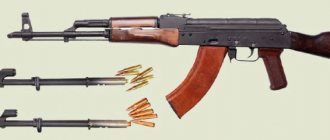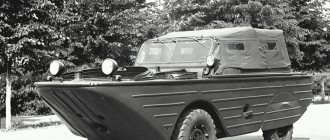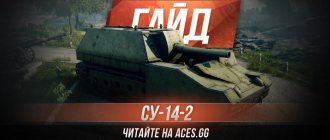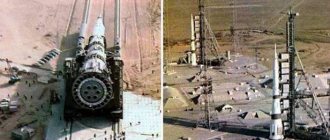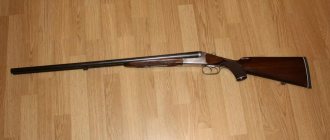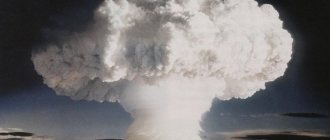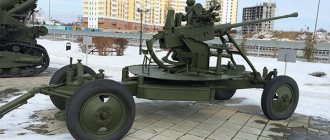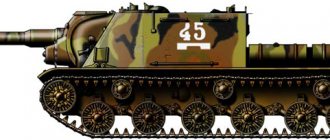| 280-mm mortar model 1939 (Br-5) | |
| Caliber, mm | 279,4 |
| Instances | 47 |
| Calculation, pers. | 15 |
| Rate of fire, rds/min | 0,25 |
| Carriage speed on the highway, km/h | up to 15 (divided) |
| Height of the firing line, mm | 1920 |
| Trunk | |
| Barrel length, mm/club | 4750/17 |
| Barrel length, mm/club | 3975/14,2 |
| Weight | |
| Weight in stowed position, kg | 19 700 |
| Weight in firing position, kg | 18 400 |
| Dimensions in stowed position | |
| Length, mm | 8900 (without barrel) |
| Width, mm | 2710 |
| Height, mm | 2600 (without barrel) |
| Ground clearance, mm | 320 |
| Firing angles | |
| Angle BH, degrees | from 0 to +60° |
| Angle GN, degrees | 8° |
The 280-mm mortar of the 1939 model
(
Br-5
) is a Soviet high-power mortar of 280 mm caliber from the Second World War. This artillery system was the largest caliber mass-produced Soviet artillery piece. The mortar had an original layout - it used a tracked carriage, common for two more powerful artillery systems. Despite the small number of guns produced and a number of shortcomings, the mortar took part in the Great Patriotic War, was modernized after its end and was in service with the Soviet army for a long time.
History of creation
Barrel with recoil device 280 mm Schneider mortar in Warsaw fort
Soviet high-power artillery inherited from the Russian Imperial Army two samples of particularly powerful artillery systems - the 280-mm Schneider mortar mod. 1914/15 (25 guns) and a 305-mm howitzer mod. 1915 (31 guns). By the mid-1930s, these guns were outdated both morally and physically; in addition, their quantity was assessed as insufficient (in particular, taking into account the mobilization reserve in 1941, it was necessary to have at least 66 280-mm mortars). There was a need to create and launch mass production of new models of particularly powerful guns, including 280-mm mortars. The caliber of the new artillery system was determined by the desire to use existing ammunition reserves. Since the 203-mm B-4 howitzer was put into service in 1931, and the development of a project for a 152-mm long-range gun was also underway, it was decided to create a triplex - three different artillery systems using the same carriage, which greatly simplified the production and operation of the guns. As in the case of the 152-mm long-range cannon, the creation of the 280-mm mortar was undertaken by competing design bureaus and “Barricades”. The mortar project received the designation B-33, the project was led by engineer Krupchatnikov. The mortar's barrel was manufactured in 1935, and the mortar was sent for factory testing on February 1, 1936. The design features of the gun were a bonded barrel made of a pipe, casing and breech, as well as a piston bolt from a Schneider mortar. The barrel was mounted on the carriage of the B-4 howitzer without a balancing mechanism, since it was balanced by adding weight to the breech. The mortar was sent to field tests on April 17, 1936; in general, they were completed successfully and, based on their results, it was recommended to send the mortar for military tests after eliminating the identified deficiencies. The project of the 280-mm mortar, designated Br-5, was led by I. I. Ivanov. The mortar underwent factory testing in December 1936. Field tests of the mortar began in April 1937; according to the conclusion of the commission, Br-5 did not withstand the test. However, it was the Br-5 that was put into mass production under the official name of the 280-mm mortar mod. 1939
, and the first order for the production of mortars was issued even before the end of field tests, in May 1937. The reasons for choosing the Br-5 instead of the B-33 are unknown; in tests, the latter showed better results, in particular greater accuracy and a higher rate of fire, and was also less massive compared to the first. Historian A. B. Shirokorad believes that the choice was voluntaristic in nature. The prototype B-33 was used in the interests of the Br-5 program, and in March 1939 it was transferred to study.
Production[
The first order for 8 Br-5 mortars was issued in May 1937. Later, due to the imperfection of the system, the number of guns ordered for 1937 was reduced to two, but they could not be manufactured either that year or the following year. These two experimental mortars were delivered to the test site in June 1939 and differed from each other in the loading method. Based on the test results, a loading method similar to that used in the B-4 howitzer was chosen. In addition to these two prototypes, another 20 mortars were manufactured in 1939, and the last 25 guns were manufactured in 1940, at which point their mass production was discontinued.
Tactical and technical characteristics of the Br-5 mortar
— Caliber, mm: 279.4 — Instances: 47 — Crew: 15 people
Rate of fire of the Br-5 mortar
— 0.25 rounds/min
Weight of mortar Br-5
— Weight in stowed position, kg: 19,700 — Weight in combat position, kg: 18,400
Overall dimensions of the Br-5 mortar
— Length, mm: 8900 (without barrel) — Width, mm: 2710 — Height, mm: 2600 (without barrel) — Ground clearance, mm: 320 — Barrel length, mm/club: 4750/17 — Barrel bore length, mm/ club: 3975/14.2
— Angle of fire VN, degrees from 0 to +60° — Angle of fire GN, degrees 8°
— Height of the firing line, mm: 1920
— Carriage speed on the highway, km/h: up to 15 (divided)
Modernization
The unsuccessful design of the triplex gun carriage became the basis for initiating work on the development of a new wheeled carriage, devoid of the shortcomings of the original tracked design. In 1938, the Main Artillery Directorate approved the tactical and technical requirements for a new wheeled carriage for a high-power duplex (152-mm Br-2 cannon and 203-mm howitzer B-4); in 1940, it was proposed to develop this carriage for the Br-5. The executor of the task was the design bureau of plant No. 172 (Perm plant) under the leadership of F. F. Petrov. The carriage received the M-50 index, but work on it proceeded extremely slowly due to the heavy workload of the design bureau with work on other systems. As a result, by the beginning of the war, everything was limited to the development of the project, after which all work was stopped. In 1955, the Br-5 (along with other triplex guns B-4 and Br-2) underwent a major modernization; a new wheeled carriage was developed for these mortars (the chief designer of the project was G.I. Sergeev). The carriage of the gun became inseparable, and its speed increased significantly - up to 35 km/h on the highway. The modernized mortar received the Br-5M
.
Further work on 280 mm mortars
In 1944, at the TsAKB, under the leadership of V.G. Grabin, work began on creating a duplex of a 180-mm cannon and a 210-mm howitzer on a single carriage; in 1945, the duplex turned into a triplex - a 280-mm mortar was added. In 1947, a 203-mm howitzer gun also appeared in the system. The project was completed in 1953; in 1955, seven 180 mm S-23 cannons, one 203 mm S-33 howitzer and one 280 mm S-43 mortar were delivered. At this point, work on the system was stopped, and the manufactured guns were sent to the Moscow Military District. In the 1970s, production of the S-23 was restored. In 1954-1955, the Central Research Institute-58 developed a triplex project on a self-propelled carriage, which included a 210-mm S-110A cannon, a 280-mm S-111A gun-howitzer and a 305-mm howitzer. There is no detailed information about the fate of this project.
Description of design
Trunk
The mortar's barrel is fastened, double-layered, and consists of a pipe, a casing and a breech. The pipe consists of a rifled part and a chamber; in the barrel part, the pipe has a thickening to balance the barrel. The rifled part has 88 grooves of constant steepness, the width of the grooves is 6.97 mm, the width of the field is 3 mm, and the depth of the grooves is 3.4 mm. The chamber consists of two conical and one cylindrical parts. The length of the chamber is 521.4 mm, the volume of the chamber is 18.159 dm³ (for a concrete-piercing projectile). The casing is put on the pipe in a hot state with a tension of up to 0.4 mm in the lock, which prevents the pipe from moving relative to the casing. The breech is a steel forging screwed onto the end of the casing; the breech structure is generally similar to that of the B-4 howitzer. The piston bolt, Schneider type, is locked in two strokes, similar in design to the bolt of the B-4 howitzer, but larger in size.
Recoil devices
Air-hydraulic recoil devices. The recoil and retraction brake cylinders are installed in couplings secured by goujons to the cradle. The cradle lies with axles in the axle sockets of the upper machine and is movably connected with its sector to the gear of the main shaft. The recoil brake is hydraulic and contains 41 liters of spindle oil. The knurling is hydropneumatic, contains 63 liters of spindle oil, air pressure - 40 atm. The rollback at elevation angles from 0 to 30° is long (1300–1410 mm), at elevation angles from 30 to 42° variable (850–1410 mm), at elevation angles from 42 to 60° short (850–880 mm). Recoil devices are motionless during rollback. Unlike the carriage of the B-4 howitzer and the Br-2 cannon, the recoil brake of the carriage of the Br-5 howitzer has keys of variable cross-section, which made it possible to rearrange the barrels of different guns on the same carriage only in the factory (the recoil brake must be replaced).
Carriage
The carriage is tracked and consists of an upper machine, a lower machine and a running gear. The upper machine is a riveted structure, supported by three rollers on the supporting surface of the lower machine and moved using a rotating mechanism on a combat pin in a horizontal plane. The lower machine in the frontal part is attached to a combat axis of circular cross-section, the ends of which are movably connected to the caterpillar track. The trunk part of the lower machine has two coulters - a constant one for hard soil and a folding one for soft soil. The lower machine of the Br-5, in comparison with the early machine of the B-4 howitzer, is additionally strengthened by riveted sidewalls and a thicker top sheet. The chassis includes a caterpillar track, a braking device, suspension, and a winch for turning the howitzer.
Guidance mechanisms and sighting devices
Sector-type lifting and rotating mechanisms. There is a special loading mechanism that ensures quick adjustment of the barrel to a horizontal position. The sighting device consists of a sight, a panorama and a sight drive with a bracket.
Charging device
The loading device consists of a crane with a winch, a frame, a mechanism for locking the shaft bringing the loading angle to the loading angle, a rack with a tarpaulin and a projectile trolley. The loading of the gun took place as follows: the shells were taken out of the cellar and placed on a wooden platform. The projectile, prepared for transportation to the mortar, is installed vertically. Next, the fighter from the crew rolls the projectile cart towards the projectile and covers the projectile with the help of grips. Then the projectile is placed on a cart and secured to it, after which it is transported on a cart to the rack and placed on a tarpaulin. The rack is installed near the carriage under the crane, the frame is lowered into the rack slot and the next projectile lying in the rack is placed in the frame. The mortar is brought to the loading angle, after which the shaft of the loading drive mechanism is locked. The kokor is hung on two hooks located on the breech of the gun barrel. After hanging the kokor, the cable is slightly weakened, while the paws of the kokor levers release the projectile, which is sent into the barrel through the efforts of four fighters.
Limber and gun cart
The gun is transported over long distances separately (the barrel is separate from the carriage). For short distances (up to 5 km), it is permissible to carry a gun with an extended barrel at a speed of no more than 5-8 km/h. For transportation by mechanical traction, the gun had a front end weighing 1300 kg with a coupling device. When transported separately, the barrel was transported on a sprung gun wheeled vehicle Br-10 (cart weight with barrel 11,300 kg, without barrel 5,400 kg) at a speed of up to 25 km/h. The transition of a gun from a combat position to a traveling position when transported separately took from 45 minutes to 2 hours, depending on the time of year and the type of soil. The guns were towed by Voroshilovets tracked tractors, and the gun carts were towed by less powerful Komintern tracked tractors.
A proletarian thresher or what the super-heavy Soviet self-propelled gun Su-28 could have become
Home » Alternatives to World War II » Proletarian thresher or what the super-heavy Soviet self-propelled gun Su-28 could have become
Editor's Choice Alternatives to World War II
Ansar02 06/29/2020 1744
16
in Favoritesin Favoritesfrom Favorites 9
In 1933, a group of the “coolest” artillery specialists in the country, including self-propelled artillery, represented by comrades: Ordzhonikidze, Tukhachevsky, Pavlunovsky and Khalepsky, came up with the idea of making the Red Army happy with a “Large self-propelled triplex” in the form of a 254-mm gun, 305- mm howitzers and 400-mm mortars on a uniform carriage (SELF-PROPELLED!!!), for action against particularly important objects and the destruction of long-term reinforced concrete fortifications. They smoked a lot of weed and or drank something drastic - who knows.
Even the first drafts of the designers’ calculations forced our high-ranking clowns to abandon the 400 mm mortar, turning the “triplex” into a “duplex”, with the gun caliber reduced from 254 to 210 mm.
Strict transport restrictions (main bridges, railway platforms) with a carrying capacity of up to 60 tons forced the sturgeon to be cut back. Now, the “duplex” has been reduced to 203 mm howitzers and 305 mm mortars.
Moreover, a 203 mm self-propelled howitzer was already being developed - the same SU-14, which was supposed to be supplemented on a uniform chassis with a long-range 152 mm cannon and a powerful 280 or 305 mm mortar.
But the new supertriplex had to be much longer-range, so that if necessary, it could also be used for coastal defense!
The fact that even with such significantly “cut down” expectations it is in principle impossible to meet the tonnage limit did not bother our “strategists” at all. They gave the go-ahead to convert their super-self-propelled gun into a collapsible one! The artillery and chassis were separated and could be transported separately by rail on standard platforms, or transported across capital bridges with a load capacity of up to 60 tons.
When assembled, the weight in the technical specifications was limited to 80 tons. But the designer’s specifications did not meet the requirements. The weight of the self-propelled guns has crept to 106 tons! Nevertheless, this same SU-7 was supposed to be built in series! We made a life-size model. For the first self-propelled guns, working drawings were already being produced and parts of the hulls and mechanisms were being manufactured. At the 185th plant of Spetsmashtrust, the assembly of the chassis was even started.
The last “wish” of the customers before they were “cleaned up” was a strange desire to provide the ability to fire sub-caliber 203 mm howitzer shells from a 305 mm mortar! Moreover, preliminary experiments showed that the dispersion is excessive. Geniuses - what to take from them?
The end of this epic, which stretched until 1937, is natural. The purge threw out extreme amateurs (not all of them, and sometimes the wrong ones) from the ranks of the Red Army, and a lot of developments that had wasted gigantic government funds were put to rest. And not all of them deserved it! But, “the new broom sweeps cleanly” and the Red Army faced the war without self-propelled guns at all (unless the KV-2 artillery tank is included in this category).
Now, let's try an alternative on the theme of the largest and heaviest self-propelled gun of the Red Army of the 30s! NOT SERIOUSLY, of course, but just to make it weird - now, thank God, they don’t shoot you for this!
Since we already have a 203 mm SU-14 howitzer (both RI and an alternative), let’s think about an even more powerful self-propelled gun. The most powerful!
First of all, let’s decide for ourselves the question: are such ultimate self-propelled guns of the Red Army necessary at all? Maybe it will make do with simple, towed artillery systems - in defiance of those extreme RI strategists. For them, everything was obvious - the positional nature of the WWI required the creation of artillery of special power, sharply and most importantly quickly reinforced in the key moth area only by equally powerful self-propelled guns.
To further clarify the issue for ourselves, let us turn to the experience of the Winter War. This is all the more obvious since there were only one or two roads and major bridges there, and there were quite a few.
The Red Army tried to break into the long-term Finnish defenses using towed 203 mm howitzers and even 280 mm mortars. The results turned out to be unimportant.
Let's start with the fact that to tow artillery systems of this caliber and, accordingly, weight, in difficult road conditions, the Red Army simply did not have the appropriate artillery tractors. The mighty "Voroshilovets" was finishing testing, and the only sufficiently powerful artillery tractor, the "Comintern", could tow these artillery systems only in disassembled form (the 203 mm B-4 howitzer was disassembled into two parts, and the 280 mm Schneider mortar into four). Of course, at parades, the Comintern carried the same B-4 in assembled form, but with a very large overload, unacceptable in difficult field conditions.
Even if there was banal icy conditions on the road, the same B-4 assembly could only be towed by two Cominterns pulled by a train.
(“Comintern” from B-4)
In addition, during the transportation of 203 and 280 mm artillery systems to the front line, there was a total failure of the carts on which parts of the guns were transported. And with 203 mm B-4 howitzers, breakdowns of the caterpillar carriages were a common occurrence. In the year we are considering, 1933, the Red Army did not have any other means of traction for heavy guns other than the low-speed Kommunar tractors.
(The Kommunar tractors are pulled by assembled 19-ton B-4s for wear and tear)
And for that “Kommunard”, in more or less difficult road conditions (not to mention completely off-road conditions), the mass of even disassembled special-purpose guns was excessive.
Another problem was time. To equip a position for such heavy towed artillery systems, engineering equipment and a large amount of work were required. Then, these same artillery systems still needed to be delivered, assembled and manufactured for firing.
The time required for all this was calculated in hours!
Since the GN angle of towed heavy artillery systems is very small, turning them by an angle exceeding this value also took quite a lot of time.
At the same time, in no case should we forget about such things as the not too high range of heavy howitzers and especially mortars (it’s not for nothing that some people so wanted to get long-range guns with a caliber of 210 mm in the most powerful triplex!), their extremely lousy camouflage ability , due to its large dimensions and, accordingly, vulnerability.
Simply put, any well-equipped, modern enemy army (not like the Finns) will have enough time to detect the positions of those monsters in advance and either bombard them with shells from lighter and longer-range guns of smaller caliber, or cover them with an airstrike from under which they will not go anywhere!
At the same time, any order to change position led to the start of another large and long job, which would be tolerable during the siege of some fortress that did not have the means of counter-battery warfare, but by no means in a modern war, which required an instant reaction to a change in the situation and, accordingly, increased mobility including from artillery of special power.
But heavy self-propelled guns easily solve most of these problems.
The vehicle, albeit very large, is capable of moving across capital bridges (up to 60 tons) or fording water obstacles (for the RI heavy self-propelled gun SU-14 this is almost one and a half meters deep!), moreover, it has a fairly powerful engine and a small average specific pressure on the ground (for the same cross-country ability), the enemy can suddenly advance to the front line, turn around on suitable terrain (topographical reference can be made in advance), quickly shoot and leave the affected area before the enemy detects the self-propelled guns and opens a response fire or organizes an air strike by strike aircraft.
In principle, there is no question at all: either towed heavy artillery systems or self-propelled ones - IMHO, the army of a state that considers itself great should have both! I personally am against any extremes. Including those, RI, technical ones.
Well, here we go! Let’s make a reservation right away - since the load-carrying capacity of capital bridges for automobile and tractor transport, as well as large four-axle railway platforms, was limited to a mass of 60 tons, the same restrictions automatically apply to our heavy self-propelled guns. On principle, we will not deal with the super-heavy monsters that Tukhachevsky raged about!
(German 600 mm self-propelled mortar “Karl” model 1940. Combat weight 126 tons. Only 6 mortars were manufactured. Probably these are the self-propelled guns that Tukhachevsky and his comrades dreamed of)
So here it is. In order to save time and weight, we will begin to create our own, much more modest self-propelled guns based on what is at hand, without reinventing the wheel and without aiming at some kind of wunderwaffles.
In general, we have to crossbreed the good old 280 mm Schneider mortar mod. 1912
(In 1933, there were at least 20 of them in the arsenals of the Red Army)
from the chassis of the T-35A heavy tank.
(Heavy tank T-35A)
All the same, this tank disappointed the military as soon as it appeared in the army.
And there was a reason! The tank was ordered by the Department of Motorization and Mechanization of the Red Army, having invented TTT, supposedly optimally corresponding to the doctrine of strengthening infantry in defense and light armored vehicles in offensive with this supertank.
Hence its armament - a LONG-BARREL (at that time), semi-automatic three-inch PS-3 and two rapid-firing 37 mm "high-power" guns. Plus a bunch of machine guns. The weight of the vehicle should not exceed 37 tons, with armor protection of 30-40 mm, not penetrated from the main battle distances by enemy tank and anti-tank guns.
But our brilliant engineers sold the Red Army a 52-ton monster, which turned out to be unable to take part in a maneuver war either in defense or in the offensive. The only niche left was the breakthrough of heavily fortified strips, but even here it “let us down”, being protected instead of 30-40 mm by only 20-30 mm armor with useless weapons in the form of a dead regiment-butt and two anti-tank “forty-fives”!
It is asked in popular Chinese: NAHUA to a heavy tank, suitable due to its innate clumsiness, only for breaking through heavily fortified defense lines, slowly crawling through anti-tank barriers that are completely impenetrable for tanks of other classes, TWO anti-tank guns and not a single one capable of breaking let alone pillboxes, and at least reinforced concrete gouges and tetrahedrons to simply clear the way for yourself?
Therefore, it is not surprising that even BEFORE the start of serial production in 1934, or rather already on August 13, 1933, the army requested a more combat-ready heavy tank instead of the T-35A (with which, however, there was a bummer - since the development of a fundamentally new tank was already at the first year of release of its predecessor - too expensive even for the USSR!).
So let’s take all these senseless “ceremonial horror stories” T-35A from the armored forces and figure out how to make them into really useful heavy (more precisely, in comparison with the SU-14, moderately super-heavy) self-propelled guns. Fortunately, having received the first 10 production vehicles only in 1934, the tank crews quickly realized that they had simply been cheated (we will not assume it intentionally!).
We are not refusing the alternative SU-14, but a 203 mm howitzer is not enough, and a heavier artillery system cannot be piled onto its chassis. Therefore, on the original T-35A chassis we are “sculpting” another, more solid self-propelled gun. The biggest it can bear!
If we compare the mass of the Schneider mortar rocker (7.8 tons) and the weight of the tank’s five turrets with all their contents (no more than 5 tons), then the comparison will not be in favor of the already overloaded T-35A chassis. Accordingly, the tank will have to not only be freed from the turrets, but also significantly de-armored. There is nothing wrong with this - we do not have an assault weapon and we need armor that is purely anti-fragmentation. We dismantle the 50 and 30 mm armor plates from the front projection of the hull. We will replace the 20 mm side armor. We will remove the roof over the fighting compartment. We'll make do with 13 mm all-round armor protection for the hull (this is exactly the kind of armor that was then mass-produced for the production of light tanks). Plus an 8 mm box-shaped shield (or half-frame), covering the artillery unit from the front and partly from the sides, and side screens of the same thickness covering the suspension. Naturally, we do not forget about the sufficient rigidity of the hull - fortunately, at that time our thin-armored tanks did not yet have load-bearing hulls!
Having thus removed the excess armor, we can easily compensate for the overload, remaining at the same weight that the T-35A had - i.e. approx. 52-53 t.
As on the same age as our self-propelled mortar RI SU-14, for firing we will add to the chassis design a suspension release mechanism and two stern jack-type stops with a hydraulic drive.
(Self-propelled 280 mm mortar SU-28.1 model 34 g.)
Such a self-propelled gun could be tested already at the turn of 34-35.
Since the time is early, it is obvious that this self-propelled gun will not show particularly brilliant results during testing.
The cross-country ability and reliability of the units are at the level of the T-35A - that is, lousy. Handling is extremely difficult. When using a purely original suspension, one cannot rule out its breakdowns when firing even with stern stops - the power of a 280 mm mortar is enormous, and the mechanism for turning off the suspension is still unfinished. And it’s not a fact that those same stern stops won’t break first. In addition, such a self-propelled gun has an extremely small ammo capacity - I suppose no more than 4 rounds, since this is already a ton of cargo!
The military, expressing all these complaints to the design engineers, as if they were relatives, diligently tried to explain to them that the self-propelled guns should have good maneuverability and controllability accessible not only to the hero Ilya Muromets. Must be able to shoot without the risk of destroying the suspension and other fillings. And it takes a long time to shoot - in heavy artillery, at least 4 first shots were always considered purely sighting shots. Well, to be sure to hit the target, it is advisable to have the same amount with you! Ammunition transporters are, of course, good, but given the time required to reload such a heavy ammunition, it is better to carry a second ammunition on them and carry out the reloading after leaving the position - somewhere a little further from the place where it is likely that the “reciprocal hotel” will soon arrive. .
In general, the car was approved, but in this specific form, it was most likely rejected and sent for revision.
The designers of Spetsmashtrust spent a long time and diligently racking their brains on how to bring it to fruition and at the same time comply with all the wishes of the military.
They found only one solution, but it was damn “creative” - to lengthen the chassis by another suspension bogie. Naturally, strengthening all suspension elements, since the longer the chassis, the worse its adaptability to the terrain and, accordingly, the load on each specific element increases.
Surely such a “creative” has never happened before - usually everyone tries, on the contrary, under any pretext, to tear off the fourth bogie from the T-35A so that it becomes lighter and more maneuverable, rather than adding a fifth, thereby turning the tank chassis into an awkward carriage on tracks! But no one forbids us to do weird things! Agree - compared to the 106-ton RI monster, any perversions with the T-35A chassis are innocent pampering.
And now about the pros and cons.
1. One of the main problems of the T-35A was “acute heart failure” - the engine cooling system could not cope, and the limited volume of mechanical maintenance did not allow improving its performance. Now, nothing prevents you from either increasing the area and volume of the radiators, or dramatically increasing the “air exchange”.
2. Since both the main clutch and final drives were multi-disc, metal on metal, strengthening them is, in principle, not a problem. It’s not a fact that this will be required at all - in a car that is only a few tons heavier than the 50-ton original chassis, and the existing transmission, with high-quality manufacturing and competent operation, will probably work satisfactorily - it’s not for nothing that the RI T-35A (until all sorts of invariably modernizations that made it heavier) could take climbs of 30 degrees (BT-5 took climbs of up to 32 degrees), and its transmission was “matched” to the new SMK and T-100 tanks, the mass of which in the original specification was determined at 60 tons!
The big problem with the T-35A was the reliability of the gearbox. But here you can at least strengthen the existing gearbox (which has been done several times), or even lubricate a new one - yourself or order it from the Italians from Ansaldo, who were just at that time trying to sell us their 90-ton super-heavy tank.
3. An extra suspension bogie on a relatively light, thin-armored hull (and we’ll also make the shield with screens thinner - 6 mm instead) will not only significantly increase the load-carrying capacity of the chassis, but also reduce the specific pressure on the ground, improving maneuverability. The goosenecks will most likely be required to be stronger (loads for turns will increase). But it was then that the USSR raised the question of making tracks from Hartfield steel and hardening the fingers with high-frequency currents. Both of these problems were successfully solved.
not only significantly increase the load-carrying capacity of the chassis, but also reduce the specific pressure on the ground, improving maneuverability. The goosenecks will most likely be required to be stronger (loads for turns will increase). But it was then that the USSR raised the question of making tracks from Hartfield steel and hardening the fingers with high-frequency currents. Both of these problems were successfully solved.
4. The engine was initially used as a “standard” tank M-17T 400-500 hp. (depending on rpm). For a “long” self-propelled gun this is not enough, just as it was not enough for the T-35A. Especially for the T-35A, the Republic of Ingushetia developed an uprated M-17L engine (one of the M-17F variants) that developed a power of 580-700 hp. With a normally balanced transmission and gearbox, its power is quite enough for such a self-propelled gun to quietly drive at a speed of about 25 km/h without strain. And she doesn’t need more - so as not to shake the art. Moreover, practically no medium or heavy artillery tractor with a heavy load “on the hook” ran faster than 25 km/h.
By the way, 54 ton T-35A model. '39 with the same engine developed 30 km/h, the 48-ton SU-14 (without armor) 32 km/h (though with a different transmission, which in principle was not tasked with achieving maximum speeds), and the suspended one 30-50 mm armored and heavier to 64 tons, the same Su-14 somehow hobbled at 22 km/h.
(SU-14-1 with 152 mm cannon and 30-50 mm armor protection)
Considering that our self-propelled gun does not carry such heavy armor as the SU-14, and will pull about 60 tons, I’m almost sure at 25 km/h. Again, the large internal volume allows you to carry a substantial supply of fuel.
5. Since the self-propelled gun turns out to be long and, in general, quite heavy, with, according to its proportions, very lousy agility (which, however, is critical for a constantly maneuvering tank, and not for self-propelled guns), in order to facilitate the work of the driver (loads on the control levers and in the T-35A were already considered limiting), let us remember the pneumatic system of control amplifiers developed for the Grote Tank (TG). According to the testers, it was a pleasure to drive a heavy car with it, although the system was unstable, primarily due to the poor quality of rubber in the seals, which led to the imbalance of the entire system. Nevertheless, this pneumatic booster design was retained on the T-35 prototype, but, again due to unreliability, it was nevertheless abolished in the production T-35A.
With just a few super-heavy self-propelled guns, we can easily afford to bring them to perfection (fortunately, the quality of neoprene has increased every year) and even duplicate this luxury for the sake of reliability!
Moreover. It is obvious to everyone, even a non-specialist, at first glance that with such a length of the chassis, the car will have a very large turning radius (unless, of course, the harp is tormented by the work), not to mention the turn. So maybe it shouldn’t be deployed again at all? If you have a pneumatic system, there is nothing simpler than making a backup, aft control station for the machine. It will be very useful in the same Karelian forests. We turned into a more or less convenient clearing, shot back and slowly, in reverse, headed home...
6. Now, about the main thing - about what this self-propelled gun was actually intended for - shooting.
Since the chassis is now long, the stops at the rear of the hull are no longer as effective. When firing at high angles, the elevations are almost meaningless (the suspension can be switched off, so the base doesn’t wobble), and when shooting flatly, the risk of their breakage is high. Therefore, instead of two stern supports, we will introduce one powerful support-pallet lowered to the ground, which is pulled out directly under the artillery system. This will ensure stability for the entire system and protect the housing from unnecessary deformations.
But we can go even further! We will introduce an effective muzzle brake and, if conditions allow the enemy to suddenly approach his positions so close that it is possible to fire with reduced charges, we will fire directly from the chassis (fortunately, it is, of course, reinforced compared to a conventional tank and there is a mechanism for turning off the suspension when shooting has already been brought to mind), without wasting precious time fiddling with the pallet (after all, it is also not stupidly trampled into the mud under the hull, but smoothly lowered onto any kind of reinforcement - say, in the form of banal wooden beams, and this is time!).
7. The additional internal volume and additional load-carrying capacity of the chassis will allow the transportable ammo capacity to be at least doubled - just what the military needs. Plus, it will be possible to significantly mechanize the loading process - the mass of the projectile is no joke. This mortar used two types of “particularly powerful” “mediocre” projectiles weighing approx. 250 kg and “heavy” weighing 286 kg. Moreover, in the USSR in the 30s, shells were not produced - in WWI there were a lot of them received from the allies, enough for all the pre-war years, and at the turn of the 30-40s, both the Schneider mortar and the new 280 mm Br-5 mortar were provided with several types of ammunition, most of which were developed before the revolution. By the way, under the Tsar-Father, the mortar was successfully tested by firing high-explosive bombs weighing from 300 to 346 kg!
The range for a mortar, and at the end of the 30s, is quite acceptable: with a high-explosive projectile weighing 286 kg - 6700 m, with a concrete bomber weighing 246 kg - 7360 m, with old Russian or French steel grenades weighing from 200 to 213 kg - from 7860 to 11,000 m. It’s not for nothing that some sources call this artillery system not a mortar, but a howitzer. The new 280 mm mortar Br-5 had a similar range (maximum 10950).
By the way, the rate of fire of the Schneider mortar was several times higher than that of the new Br-5 and reached a shot per minute.
This is the kind of car that we end up with! Land battleship, “swing it there”!
Yes, the car is long, yes, with terrible agility, yes, relatively heavy. But on the other hand, it can be fully developed by the 36th (let’s call it SU-28) and in the period from 36 to 38. 12 self-propelled guns could easily be produced for the Red Army (36 T-35A tanks were produced in the Republic of Ingushetia in the same years). 9 self-propelled guns in a separate regiment of self-propelled guns of special power consisting of 3 batteries of 3 vehicles each. Another 3 self-propelled guns are a reserve for some kind of solid training unit. In “extreme cases” like the Winter War, it’s quite enough in addition to towed artillery.
For the same regiment, it would not be bad to make at least a couple of unarmed vehicles - tow trucks on a similar chassis. It can even be shortened to 4 or even 3 bogies (like the AI SU-14).
Of course, it is necessary to provide a support machine in advance. Naturally tracked, with similar maneuverability, which will not only carry (plus a trailer) the second armored vehicle, but will also be equipped with a bulldozer blade for operational equipment of the position and, as weapons, carry some light air defense systems. “Comintern” is quite suitable for this role.
I won’t say, but perhaps with such an “argument” the Red Army would have had a slightly better chance of breaking the Mannerheim Line earlier and with fewer losses. After all, 203 mm howitzers, the so-called, widely used in the Winter War. The million-dollar bunkers did not penetrate even with a direct hit, and most of the 280 mm mortars (18 Schneider mortars and 4 new Br-5s) that the Red Army tried to use could not prove themselves - some simply did not reach the scene of action due to numerous carts broke down, some were unable or did not dare to turn around at the most optimal distance.
(Special cart for the barrel of a 280 mm mortar)
Accordingly, they were not used as needed - instead of concentrating them in decisive areas to suppress the bunkers around which the entire defense of the Urals was built, they fired almost meaningless rapid fire at areas during the day, etc. harassing fire (for which cannons, howitzers or even mortars are usually used) at night. This only means that the slow-moving towed mortars, in those conditions, could not be used for their intended purpose. But 280 mm Schneider mortars, along with 203 mm Vickers howitzers, showed excellent performance near Przemysl in WWII.
Another photo of the 280 mm Schneider mortar.
(Photo by WWI)
(The Krauts using these mortars on the Eastern Front in WWII)
Service and combat use
Br-5 mortars were designed for:
- destruction of especially strong concrete, reinforced concrete and armored structures;
- combat against large-caliber enemy artillery or sheltered by strong structures.
Br-5 mortars took part in the Soviet-Finnish war; four such mortars were part of the 40th separate high-power artillery division from November 1939. Mortars took part in breaking through the Mannerheim line, destroying Finnish bunkers. In total, during this war, 414 shells were fired by Br-5 mortars. There is little information about the use of Br-5 during the Great Patriotic War. It is known that guns of this type were used as part of the 32nd separate artillery division of special power in March 1945 during the assault on Neustadt (part of Küstrin), as well as during the assault on Königsberg. In the memoirs of the chief of artillery staff of the 1st Belorussian Front Nadysev G.S. there is a mention of the use of 280-mm howitzers during the assault on Poznan, probably referring to the Br-5. According to military historian A.V. Isaev, the consumption of 280-mm mortar shells in 1942 and 1943 was not recorded; in 1944, 3,322 shells were spent, in 1945 - 7,363 shells. Before the war, there were about 7,000 shells available for 280 mm mortars (or 97 per gun), which was assessed as an insufficient quantity. In 1941, nine 280 mm mortars were lost. In the 1950s, the Br-5 mortars were modernized and remained in service until at least the 1970s.
Development[edit]
By the 1930s, the Red Army's siege artillery consisted of obsolete stocks of 280 mm Schneider M1914/15 (25 pieces) and 305 mm M1915 howitzers (31 pieces) inherited from the Imperial Russian Army. Obsolete guns and their insufficient number (M1914/15 - less than half of what was prescribed by the 1941 mobilization plans, 66 pieces) meant that new models were required, including 280 mm caliber. The caliber was chosen as 280 mm due to the availability of stocks of 280 mm Schneider M1914/15 ammunition. During development, the 203 mm B-4 had already been adopted for service, and design work on the 152 mm Br-2 On the move, it was decided to adopt the same carriage for the new one siege mortar, creating a “triplex”, simplifying production and operation. [3]
Both the Leningrad Bolshevik Factory and the Stalingrad Barricade Factory were tasked with submitting competing designs: Kurpchatnikov's Bolshevik design was called the B-33, Ilya Ivanov's Barricade design was called the Br-5.
The B-33 barrel was built in 1935 and was sent to factory testing on February 1, 1936. The B-33 featured a fixed barrel, shroud and breech, and a piston breech action from the Schneider mortar. The barrel was mounted directly on the carriage without any balancing by a counterweight, since the loaded breech could counterbalance the weight. The B-33, having completed factory tests, was sent for field tests on April 17, 1936, which ended successfully. Subsequently, the B-33 was recommended to correct the identified defects before being sent for military testing.
In December 1936, the Br-5 passed factory tests, and in April 1937, full-scale tests, which it failed. However, despite the fact that the B-33 showed better grouping of shells, a higher rate of fire and smaller dimensions, the Br-5 was adopted as a 280-mm mortar of the 1939 model.
, and the first production order was placed
before
the end of field testing. The reason why the Br-5 was chosen over the B-33 was unknown, but may have arisen due to the voluntaristic nature [3] of the Br-5. The B-33 prototype was sent to Barricades for study in March 1939.
Ammunition and ballistics
The Br-5 mortar had cap loading. The charge scale is individual for each of the projectiles used. The full variable charge Z-675B (5 charges) and the reduced variable charge Z-675BU (6 charges) were used for the G-675 projectile; the full variable charge Z-675 (2 charges) and the reduced variable charge Z-675U were used for the F-674K projectile (3 charges), for the F-674 projectile - full variable charge Z-675A (3 charges), for the F-674F projectile - full variable charge Z-675F (4 charges). The range of shells included three types of high-explosive shells and one type of concrete-piercing shells. High-explosive shells were not produced in Soviet times; stocks of shells from 280-mm Schneider mortars, created before the revolution, were used. The concrete-piercing projectile has been in use since 1942. Firing from a mortar at elevation angles less than 15° due to the weak stability of the system at low elevation angles was allowed only in exceptional cases.
| Ammunition nomenclature | |||||
| Type | Projectile index | Projectile weight, kg | Explosive weight, kg | Initial speed, m/s | Table range, m |
| Concrete-piercing shells | |||||
| Concrete-piercing with KTD fuse | G-675 | 246 | 44,8 | 356 | 10 410 |
| High explosive shells | |||||
| High explosive old Russian style steel grenade 3.25 caliber long with 5DT-2 fuse | F-674K | 200,7 | 33,6 | 420 | 10 950 |
| High-explosive old Russian-style steel grenade, 4.5 calibers long, with a 5DT-2 fuse | F-674 | 286,7 | 58,7 | 290 | 7350 |
| High explosive old steel cast iron grenade of the French type, 4.5 calibers long with a GVMZ fuse | F-674F | 204 | 45 | 360 | 9350 |


